display TOYOTA PROACE 2020 (in English) Owner's Guide
[x] Cancel search | Manufacturer: TOYOTA, Model Year: 2020, Model line: PROACE, Model: TOYOTA PROACE 2020Pages: 430, PDF Size: 48.01 MB
Page 172 of 430
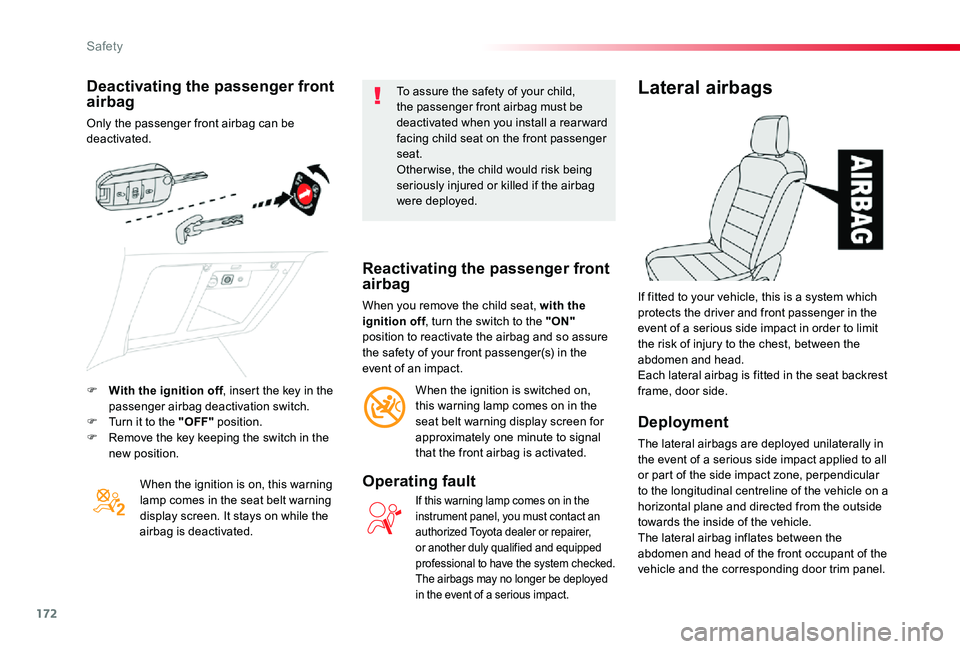
172
Deactivating the passenger front airbag
Only the passenger front airbag can be deactivated.
When the ignition is on, this warning lamp comes in the seat belt warning display screen. It stays on while the airbag is deactivated.
To assure the safety of your child, the passenger front airbag must be deactivated when you install a rear ward facing child seat on the front passenger seat.Otherwise, the child would risk being seriously injured or killed if the airbag were deployed.
Reactivating the passenger front airbag
When you remove the child seat, with the ignition off, turn the switch to the "ON" position to reactivate the airbag and so assure the safety of your front passenger(s) in the event of an impact.
When the ignition is switched on, this warning lamp comes on in the seat belt warning display screen for approximately one minute to signal that the front airbag is activated.
Operating fault
If this warning lamp comes on in the instrument panel, you must contact an authorized Toyota dealer or repairer, or another duly qualified and equipped professional to have the system checked. The airbags may no longer be deployed in the event of a serious impact.
Lateral airbags
Deployment
The lateral airbags are deployed unilaterally in
the event of a serious side impact applied to all or part of the side impact zone, perpendicular to the longitudinal centreline of the vehicle on a horizontal plane and directed from the outside towards the inside of the vehicle.The lateral airbag inflates between the abdomen and head of the front occupant of the vehicle and the corresponding door trim panel.
If fitted to your vehicle, this is a system which protects the driver and front passenger in the event of a serious side impact in order to limit the risk of injury to the chest, between the abdomen and head.Each lateral airbag is fitted in the seat backrest frame, door side.F With the ignition off, insert the key in the passenger airbag deactivation switch.F Turn it to the "OFF" position.F Remove the key keeping the switch in the
new position.
Safety
Page 203 of 430

203
The presence in the recognition zone of the remote control of the "Smart Entry & Start System" system is essential.Never leave the vehicle with the engine running and with the remote control on your person.If the remote control leaves the recognition zone, a message is displayed.Move the remote control into the zone to be able to start the engine.
If one of the starting conditions is not met, a message appears in the instrument panel screen. In some circumstances, it is necessary to turn the steering wheel slightly while pressing the "START/STOP" button to assist unlocking of the steering; a message warns you when this is needed.
If the vehicle is not immobilised, the engine will not stop.
Switching off
F Immobilise the vehicle.
F With the remote control in the recognition zone, press the "START/STOP" button.
The engine stops and the steering column is locked.
Ignition on
(without starting)
With the ignition on, the system automatically goes into energy economy mode to maintain an adequate state of charge in the battery.
With the Smart Entry & Start System remote control inside the vehicle, pressing the "START/STOP" button, with no action on the pedals, allows the ignition to be switched on.This also allows the accessories to be used (for example: audio system, lighting...).
F Press the "START/STOP" button, the instrument panel comes on but the engine does not start.
F Press the button again to switch off the ignition and allow the vehicle to be locked.
To avoid any risk of jamming of the pedals:- only use mats which are suited to the fixings already present in the vehicle; these fixings must be used,- never fit one mat on top of another.The use of mats not approved by Toyota
may inter fere with access to the pedals and hinder the operation of the cruise control / speed limiter.The mats approved by Toyota have two fixings located below the seat.
6
Driving
Page 208 of 430
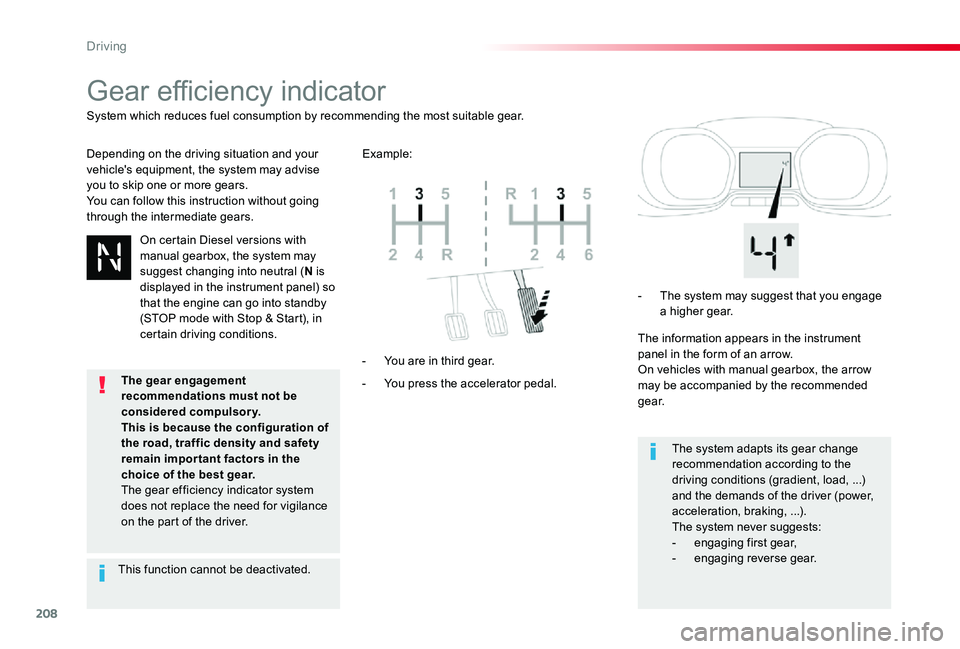
208
Gear efficiency indicator
Depending on the driving situation and your vehicle's equipment, the system may advise you to skip one or more gears.You can follow this instruction without going through the intermediate gears.
- You press the accelerator pedal.
- You are in third gear.
- The system may suggest that you engage a higher gear.
The information appears in the instrument panel in the form of an arrow.On vehicles with manual gearbox, the arrow may be accompanied by the recommended g e a r.
The system adapts its gear change recommendation according to the driving conditions (gradient, load, ...) and the demands of the driver (power, acceleration, braking, ...).The system never suggests:- engaging first gear,- engaging reverse gear.
System which reduces fuel consumption by recommending the most suitable gear.
Example:
On certain Diesel versions with
manual gearbox, the system may suggest changing into neutral (N is displayed in the instrument panel) so that the engine can go into standby (STOP mode with Stop & Start), in certain driving conditions.
This function cannot be deactivated.
The gear engagement recommendations must not be considered compulsory.This is because the configuration of the road, traffic density and safety remain impor tant factors in the choice of the best gear.The gear efficiency indicator system does not replace the need for vigilance on the part of the driver.
Driving
Page 210 of 430
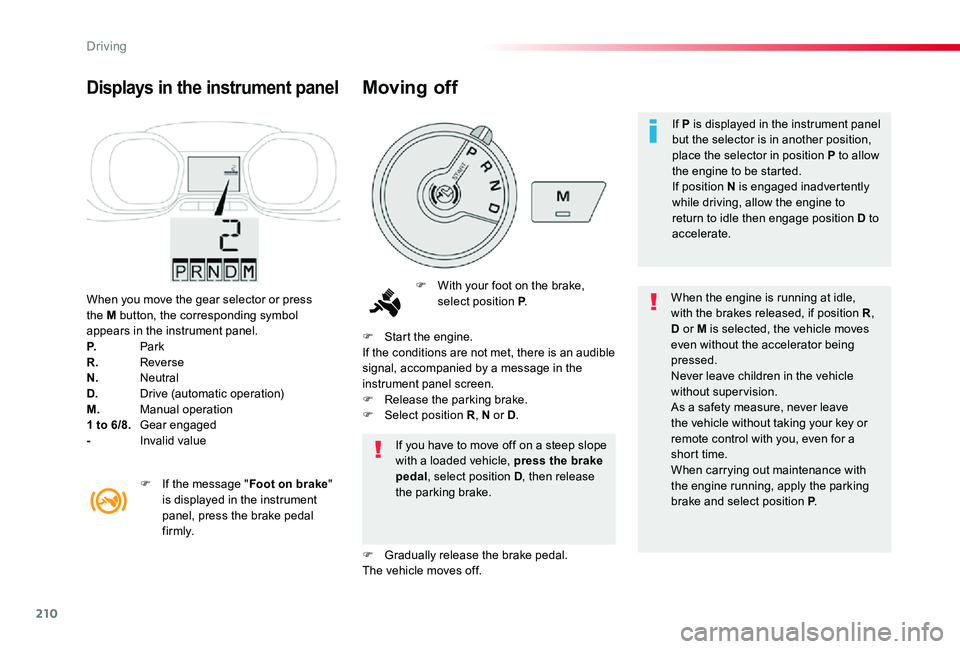
210
When you move the gear selector or press the M button, the corresponding symbol appears in the instrument panel.P. ParkR. ReverseN. NeutralD. Drive (automatic operation)M. Manual operation1 to 6/8. Gear engaged- Invalid value
Displays in the instrument panel
F With your foot on the brake, select position P.When the engine is running at idle, with the brakes released, if position R, D or M is selected, the vehicle moves even without the accelerator being pressed.Never leave children in the vehicle without supervision.As a safety measure, never leave the vehicle without taking your key or remote control with you, even for a
short time.When carrying out maintenance with the engine running, apply the parking brake and select position P.
If you have to move off on a steep slope with a loaded vehicle, press the brake pedal, select position D, then release the parking brake.
F Start the engine.If the conditions are not met, there is an audible signal, accompanied by a message in the instrument panel screen.F Release the parking brake.F Select position R, N or D.
F Gradually release the brake pedal.The vehicle moves off.
F If the message "Foot on brake" is displayed in the instrument panel, press the brake pedal f i r m l y.
Moving off
If P is displayed in the instrument panel but the selector is in another position, place the selector in position P to allow the engine to be started.If position N is engaged inadvertently while driving, allow the engine to return to idle then engage position D to accelerate.
Driving
Page 212 of 430
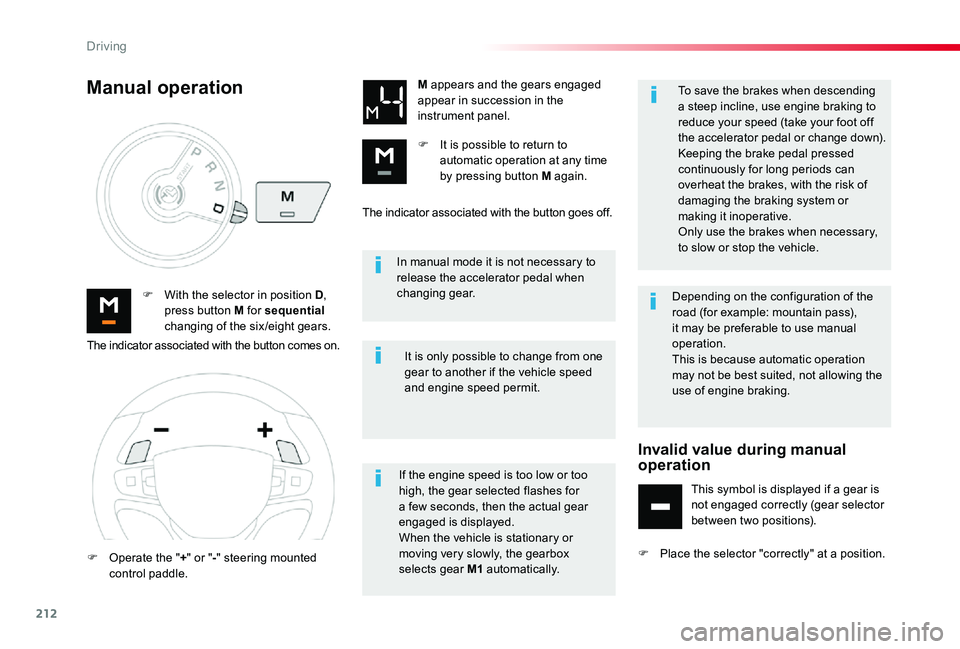
212
In manual mode it is not necessary to release the accelerator pedal when changing gear.F With the selector in position D, press button M for sequential changing of the six/eight gears.
M appears and the gears engaged appear in succession in the instrument panel.
F It is possible to return to automatic operation at any time by pressing button M again.
It is only possible to change from one gear to another if the vehicle speed and engine speed permit.
Manual operation
If the engine speed is too low or too high, the gear selected flashes for a few seconds, then the actual gear engaged is displayed.When the vehicle is stationary or moving very slowly, the gearbox selects gear M1 automatically.
To save the brakes when descending a steep incline, use engine braking to reduce your speed (take your foot off the accelerator pedal or change down).Keeping the brake pedal pressed continuously for long periods can overheat the brakes, with the risk of damaging the braking system or making it inoperative.Only use the brakes when necessary, to slow or stop the vehicle.
The indicator associated with the button comes on.
F Operate the "+" or "-" steering mounted control paddle.
The indicator associated with the button goes off.
Depending on the configuration of the road (for example: mountain pass), it may be preferable to use manual operation.This is because automatic operation may not be best suited, not allowing the use of engine braking.
Invalid value during manual operation
This symbol is displayed if a gear is not engaged correctly (gear selector between two positions).
F Place the selector "correctly" at a position.
Driving
Page 215 of 430
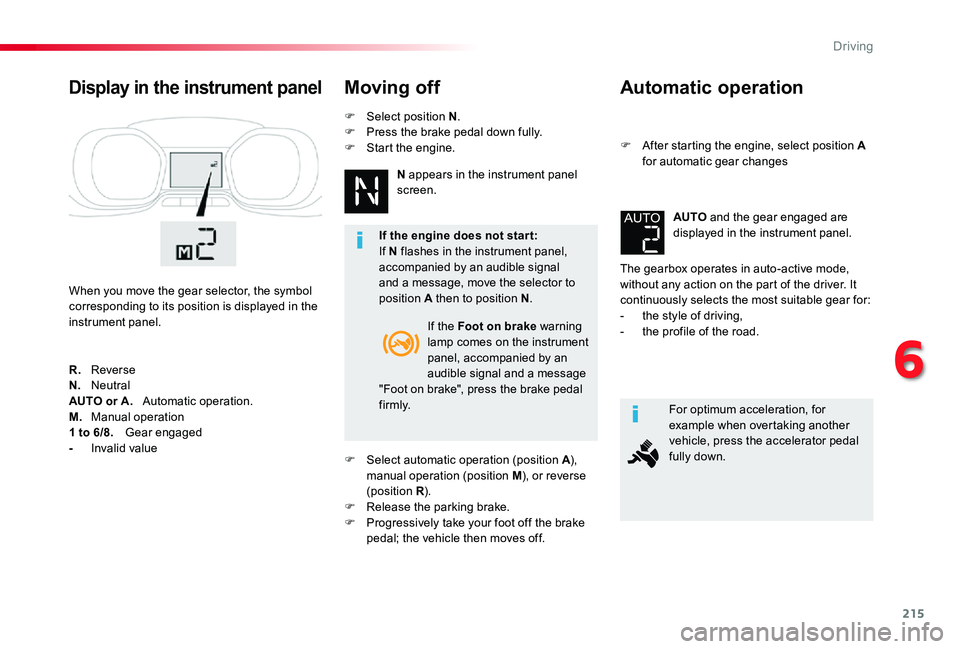
215
Automatic operation
F After starting the engine, select position A for automatic gear changes
The gearbox operates in auto-active mode, without any action on the part of the driver. It continuously selects the most suitable gear for:- the style of driving,- the profile of the road.
AUTO and the gear engaged are displayed in the instrument panel.
For optimum acceleration, for example when overtaking another vehicle, press the accelerator pedal fully down.
Display in the instrument panel
When you move the gear selector, the symbol corresponding to its position is displayed in the instrument panel.
Moving off
If the Foot on brake warning lamp comes on the instrument panel, accompanied by an audible signal and a message "Foot on brake", press the brake pedal f i r m l y.
R. ReverseN. NeutralAUTO or A. Automatic operation.M. Manual operation1 to 6/8. Gear engaged- Invalid value
If the engine does not star t:If N flashes in the instrument panel, accompanied by an audible signal and a message, move the selector to position A then to position N.
F Select automatic operation (position A), manual operation (position M), or reverse (position R).F Release the parking brake.F Progressively take your foot off the brake pedal; the vehicle then moves off.
N appears in the instrument panel screen.
F Select position N.F Press the brake pedal down fully.F Start the engine.
6
Driving
Page 216 of 430

216
Temporary manual control of gear changes
You can temporarily take control of gear changes using the "+" and "-" steering mounted control paddles. The gear change instruction is acted on if the engine speed permits.This function allows you to anticipate certain situations, such as overtaking another vehicle or approaching a bend in the road.Following a few moments with no action on the control paddles, the gearbox returns to
automatic operation.
Manual operation
AUTO disappears and the gears engaged are displayed successively in the instrument panel.
F After starting the engine, select position M for sequential gear changing
The change from one gear to another takes place only if the conditions of vehicles speed and engine speed permit; if not, the automatic operation
laws are applied temporarily.
F Operate the "+" or "-" steering mounted control paddle.
It is not necessary to release the accelerator during gear changes.When braking or slowing down, the gearbox changes down automatically to allow the vehicle to accelerate in the correct gear.
On sharp acceleration, the gearbox will not change up unless the driver acts on the steering mounted paddles.Never select neutral N when drivingOnly engage reverse R with the vehicle stationary and your foot on the brake.
Driving
Page 221 of 430
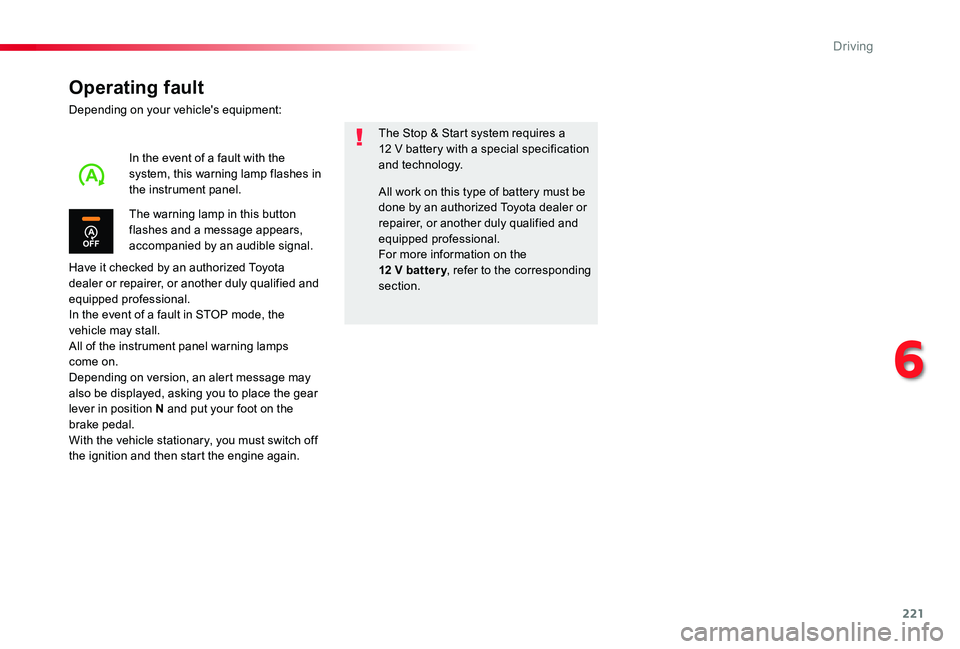
221
Operating fault
Depending on your vehicle's equipment:
Have it checked by an authorized Toyota dealer or repairer, or another duly qualified and equipped professional.In the event of a fault in STOP mode, the vehicle may stall.All of the instrument panel warning lamps come on.Depending on version, an alert message may also be displayed, asking you to place the gear lever in position N and put your foot on the brake pedal.With the vehicle stationary, you must switch off the ignition and then start the engine again.
The Stop & Start system requires a 12 V battery with a special specification and technology.
The warning lamp in this button flashes and a message appears, accompanied by an audible signal.
In the event of a fault with the system, this warning lamp flashes in the instrument panel.All work on this type of battery must be done by an authorized Toyota dealer or repairer, or another duly qualified and equipped professional.
For more information on the 12 V batter y, refer to the corresponding section.
6
Driving
Page 222 of 430

222
1. On.2. Off (long press).3. Brightness adjustment.4. Display height adjustment.
Once the system has been activated, the following information is grouped together in the head-up display:A. The speed of your vehicle.B. Cruise control/speed limiter information.C. If your vehicle is so equipped, inter-vehicle distance information, automatic emergency braking alerts and navigation instructions.D. If your vehicle is so equipped, speed limit information.
System which projects various information onto a smoked blade in the driver's field of vision so that they do not have to take their eyes off the road.
Buttons
Displays during operation
Head-up display
For more information on Navigation, refer to the Audio and telematics section.
F With the engine running, press button 1 to activate the system and deploy the blade.
Activation / Deactivation
F Press and hold button 2 to deactivate the system and retract the blade.
The activated/deactivated state is saved and retained on restarting the engine.
Driving
Page 223 of 430
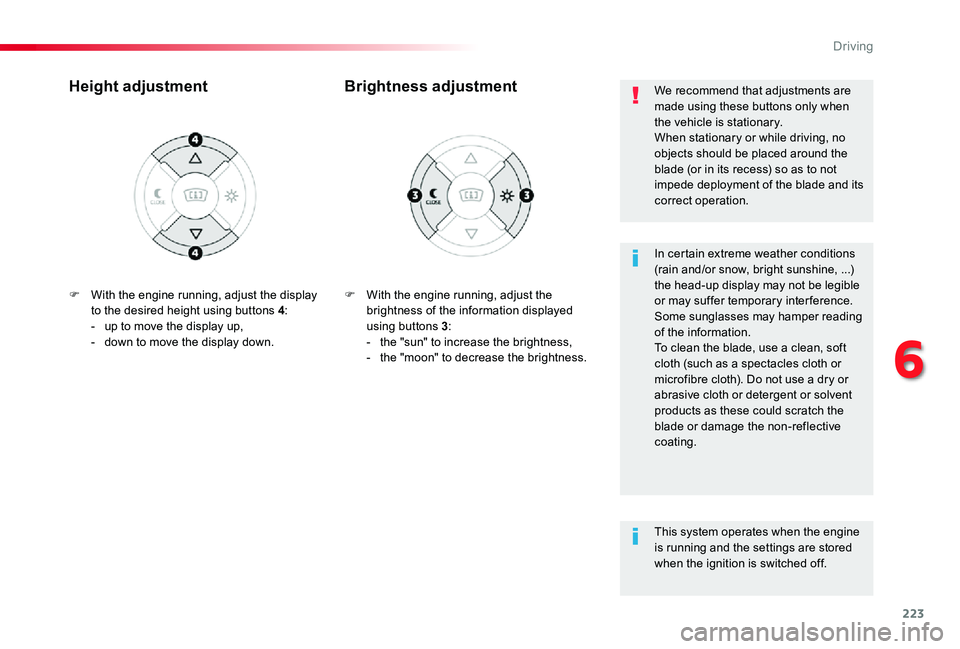
223
F With the engine running, adjust the brightness of the information displayed using buttons 3:- the "sun" to increase the brightness,- the "moon" to decrease the brightness.
Brightness adjustmentHeight adjustment
In certain extreme weather conditions (rain and/or snow, bright sunshine, ...) the head-up display may not be legible or may suffer temporary interference.Some sunglasses may hamper reading of the information.To clean the blade, use a clean, soft cloth (such as a spectacles cloth or microfibre cloth). Do not use a dry or abrasive cloth or detergent or solvent products as these could scratch the blade or damage the non-reflective coating.
We recommend that adjustments are made using these buttons only when the vehicle is stationary.When stationary or while driving, no objects should be placed around the blade (or in its recess) so as to not impede deployment of the blade and its correct operation.
This system operates when the engine
is running and the settings are stored when the ignition is switched off.
F With the engine running, adjust the display to the desired height using buttons 4:- up to move the display up,- down to move the display down.
6
Driving